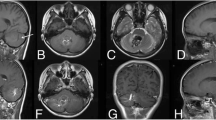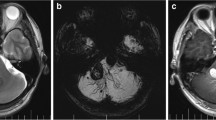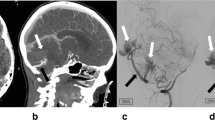Abstract
Introduction
The aim of this paper was to evaluate the angioarchitectural factors that can induce concurrent cavernous malformation (CM) in the territory of developmental venous anomaly (DVA).
Methods
From January 2006 to December 2007, 21 patients with 23 CMs in the territory of DVA were retrospectively analyzed (M; F = 12; 9, mean age = 53.3). Gadovist®-enhanced three-dimensional spoiled gradient-echo images on a 3 T magnetic resonance (MR) scanner were used. We investigated the presence of angioarchitectural factors: factor 1, the angulated course of curved medullary or draining vein in the distal portion of CM; factor 2, narrowing of distal draining vein; factor 3, severe medullary venous tortuosity. These were also analyzed for control group of 23 subjects (M; F = 11; 12, mean age = 46).
Results
Factor 1 was demonstrated in 22 cases (97%) and the CM occurred in a position of 90° or less of an abrupt angulated medullary or draining vein in 15 cases (65%) of the study group. Factor 2 was found in 13 cases (57%) with the diameter reduction of 50% or more in five cases. The mean ratio of diameter reduction was 0.53. Factor 3 was found in 17 cases (74%). Analyzing the independent factors, the p values for factors 1 and 3 were <.05, i.e., statistically significant. If combination of more than two factors was present, the p values for all the combinations were <0.05, i.e., statistically significant.
Conclusion
Anatomical angioarchitectural factors might be the key factors in causing concurrent sporadic CM within the territory of DVA by causing disturbance of blood flow.





Similar content being viewed by others
Abbreviations
- CM:
-
cavernous malformation
- DVA:
-
developmental venous anomaly
- SPGR:
-
spoiled gradient-echo
- MPRs:
-
multiplanar reconstructions
References
Boukobza M, Enjolras O, Guichard JP, Gelbert F, Herbreteau D, Reizine D, Merland JJ (1996) Cerebral developmental venous anomalies associated with head and neck venous malformations. AJNR Am J Neuroradiol 17:987–994
Hammoud D, Beauchamp N, Wityk R, Yousem D (2002) Ischemic complication of a cerebral developmental venous anomaly: case report and review of the literature. J Comput Assist Tomogr 26(4):633–636
Ostertun B, Solymosi L (1993) Magnetic resonance angiography of cerebral developmental venous anomalies: its role in differential diagnosis. Neuroradiology 35:97–104
Oran I, Kiroglu Y, Yurt A, Ozer FD, Acar F, Dalbasti T, Yagci B, Sirikci A, Calli C (2009) Developmental venous anomaly (DVA) with arterial component: a rare cause of intracranial haemorrhage. Neuroradiology 51(1):25–32
Lee C, Pennington MA, Kenney CM 3rd (1996) MR evaluation of developmental venous anomalies: medullary venous anatomy of venous angiomas. AJNR Am J Neuroradiol 17:61–70
Sasaki O, Tanaka R, Koike T, Koide A, Koizumi T, Ogawa H (1991) Excision of cavernous angioma with preservation of coexisting venous angioma. Case report. J Neurosurg 75:461–464
Wilms G, Bleus E, Demaerel P, Marchal G, Plets C, Goffin J, Baert AL (1994) Simultaneous occurrence of developmental venous anomalies and cavernous angiomas. AJNR Am J Neuroradiol 15(7):1247–1254, discussion 1255–1257
Rigamonti D, Spetzler RF (1998) The association of venous and cavernous malformations, report of four cases and discussion of the pathophysiological, diagnostic, and therapeutic implications. Acta Neurochir (Wien) 92:100–105
Dillon WP (1997) Cryptic vascular malformations: controversies in terminology, diagnosis, pathophysiology, and treatment. AJNR Am J Neuroradiol 18:1839–1846
Perrini P, Lanzino G (2006) The association of venous developmental anomalies and cavernous malformations: pathophysiological, diagnostic, and surgical considerations. Neurosurg Focus 21(1):e5
Günel M, Awad IA, Finberg K, Steinberg GK, Craig HD, Cepeda O, Nelson-Williams C, Lifton RP (1996) Genetic heterogeneity of inherited cerebral cavernous malformation. Neurosurgery 38(6):1265–1271
Awad IA, Robinson JR Jr, Mohanty S, Estes ML (1993) Mixed vascular malformations of the brain: clinical and pathogenetic considerations. Neurosurgery 33(2):179–188, discussion 188
Chang SD, Steinberg GK, Rosario M, Crowley RS, Hevner RF (1997) Mixed arteriovenous malformation and capillary telangiectasia: a rare subset of mixed vascular malformations. Case report. J Neurosurg 86(4):699–703
Abdulrauf SI, Kaynar MY, Awad IA (1999) A comparison of the clinical profile of cavernous malformations with and without associated venous malformations. Neurosurgery 44(1):41–46, discussion 46–47
Wurm G, Schnizer M, Fellner FA (2005) Cerebral cavernous malformations associated with venous anomalies: surgical considerations. Neurosurgery 57(1):42–58
San Millán Ruíz D, Delavelle J, Yilmaz H, Gailloud P, Piovan E, Bertramello A, Pizzini F, Rüfenacht DA (2007) Parenchymal abnormalities associated with developmental venous anomalies. Neuroradiology 49:987–995
Töpper R, Jürgens E, Reul J, Thron A (1999) Clinical significance of intracranial developmental venous anomalies. J Neurol Neurosurg Psychiatry 67:234–238
Günel M, Awad IA, Finberg K, Anson JA, Stenberg GK, Batjer HH, Kopitnik TA, Morrison L, Giannotta SL, Williams CN, Lifton RP (1996) A founder mutation as a cause of cerebral cavernous malformation in Hispanic Americans. N Engl J Med 334:946–951
Verlaan DJ, Laurent SB, Sure U, Bertalanffy H, Andermann E, Andermann F, Rouleau GF, Siegel AM (2004) CCM1 mutation screen of sporadic cases with cerebral cavernous malformations. Neurology 62:1213–1215
Ciricillo SF, Dillon WP, Fink ME, Edwards MSB (1994) Progression of multiple cryptic vascular malformations associated with anomalous venous drainage.Case report. J Neurosurg 81:477–481
Wilson CB (1992) Cryptic vascular malformations. Clin Neurosurg 38:49–84
Porter RW, Detwiler PW, Spetzler RF, Lawton MT, Baskin JJ, Derksen PT, Zabramski JM (1999) Cavernous malformations of the brainstem: experience with 100 patients. J Neurosurg 90:50–58
McLaughlin MR, Kondziolka D, Flickinger JC, Lunsford S, Lunsford LD (1998) The prospective natural history of cerebral venous malformations. Neurosurgery 43(2):195–200, discussion 200–201
Conflict of interest statement
We declare that we have no conflict of interest.
Author information
Authors and Affiliations
Corresponding author
Rights and permissions
About this article
Cite this article
Hong, Y.J., Chung, TS., Suh, S.H. et al. The angioarchitectural factors of the cerebral developmental venous anomaly; can they be the causes of concurrent sporadic cavernous malformation?. Neuroradiology 52, 883–891 (2010). https://doi.org/10.1007/s00234-009-0640-6
Received:
Accepted:
Published:
Issue Date:
DOI: https://doi.org/10.1007/s00234-009-0640-6




